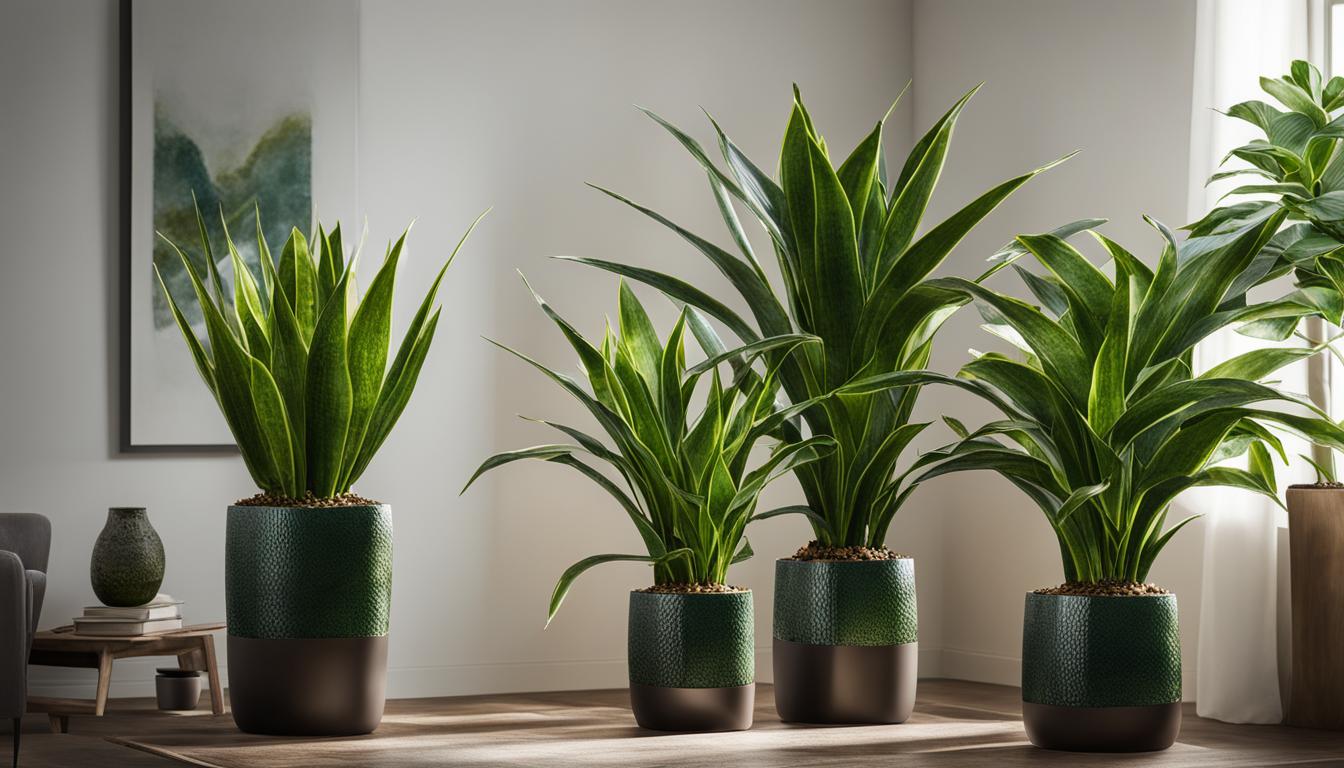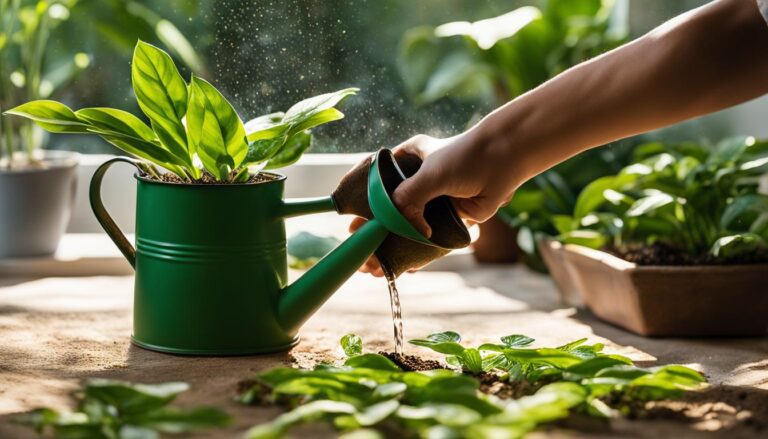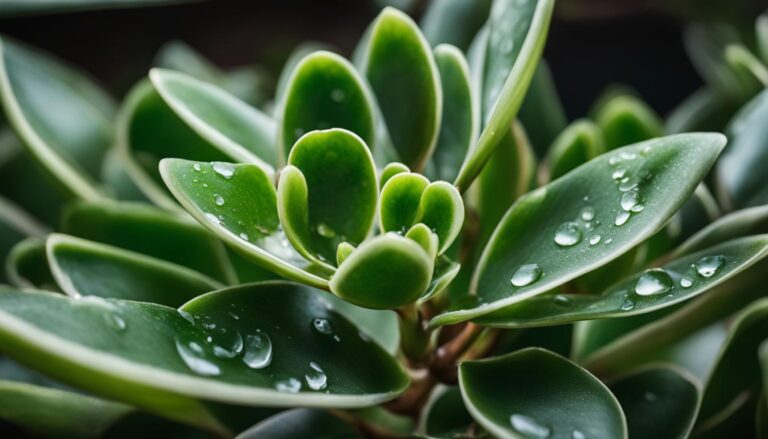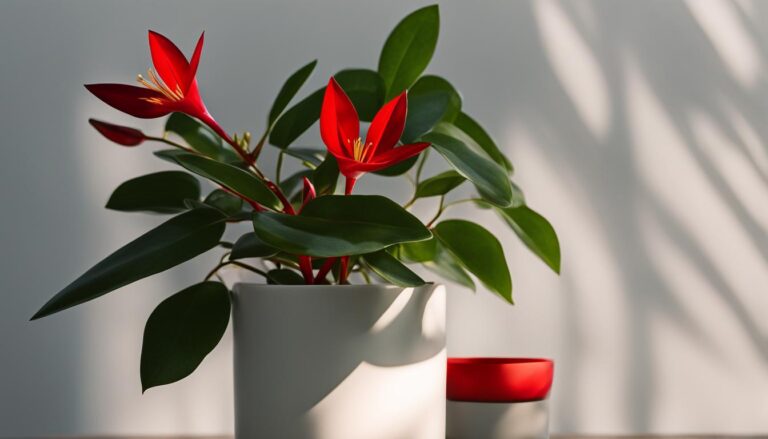
As a journalist and plant enthusiast, I am thrilled to dive into the captivating world of snake plants, scientifically known as Sansevieria trifasciata. These resilient beauties have gained immense popularity not only for their stunning appearance but also for their incredible air-purifying qualities.
Snake plants come in a variety of striking varieties, each with its own unique charm. From the elegant Sansevieria Moonshine to the bold Sansevieria Black Coral, these plants have the power to elevate the aesthetic appeal of any space.
Whether you’re an experienced plant parent or just starting your green journey, snake plants are a fantastic choice. They are known for their low-maintenance nature, making them suitable for any level of plant care expertise.
Throughout this article, I will guide you through the wonders of snake plants, sharing tips on care, propagation, and the incredible benefits these plants bring to our indoor spaces. So, let’s embark on this botanical adventure and uncover the secrets of the snake plant kingdom.
15 Amazing Snake Plants for Your Indoor Garden in 2023
If you’re looking to add some greenery to your indoor space, snake plants are an excellent choice. In 2023, there are 15 amazing snake plant varieties that can elevate the beauty of your indoor garden. These plants come in various shapes, sizes, and colors, offering a wide range of options to suit your personal taste and style.
| Variety (Scientific Name) | Water Requirements | Light Requirements | Fertilizer | Toxicity | Special Feature |
|---|---|---|---|---|---|
| Mother-in-law’s Tongue (Sansevieria Trifasciata) | Low; water sparingly | Bright, indirect light | Biannual, balanced mix | Toxic to pets | Classic variety with tall, green, and yellow leaves |
| Golden Hahnii (Sansevieria Laurentii) | Moderate | Moderate to low light | Spring to fall | Toxic to pets | Yellow-edged leaves |
| African Spear (Sansevieria Cylindrica) | Infrequent | Bright, indirect light | Low-nitrogen in spring | Toxic to pets | Tubular, cylindrical leaves |
| Whale Fin (Sansevieria Masoniana) | Minimal; drought-tolerant | Low to bright light | Every 6-8 weeks in growth | Toxic to pets | Wide, paddle-like leaves |
| Moonshine (Sansevieria Moonshine) | Moderate; allow to dry | Low to moderate light | Balanced, half-strength | Toxic to pets | Silvery-green, broad leaves |
| Bacularis (Sansevieria Bacularis) | Low; water sparingly | Bright, indirect light | Spring to fall | Toxic to pets | Upright, round, dark green leaves |
| Bowstring Hemp (Sansevieria Zeylanica) | Low | Low to bright light | Balanced during growing | Toxic to pets | Dark green, wavy cross bands |
| Samurai Dwarf (Sansevieria Ehrenbergii) | Minimal; drought-tolerant | Bright to low light | In growing season | Toxic to pets | Sword-like leaves; good for small pots |
| Star Sansevieria (Sansevieria Kirkii) | Moderate | Indirect, low light | Spring to fall | Toxic to pets | Patterned, rough-textured leaves |
| Bird’s Nest (Sansevieria Trifasciata Hahnii) | Low; allow soil to dry | Low to moderate light | Spring to fall | Toxic to pets | Short, rosette form |
| Sansevieria Patens | Low | Bright, indirect light | Sparingly in growth | Toxic to pets | Unique, patens-like foliage |
| Kenya Hyacinth (Sansevieria Parva) | Low; drought-tolerant | Bright, indirect light | In growing season | Toxic to pets | Narrow, leathery leaves |
| Samurai Sword (Sansevieria Samurai) | Low; drought-tolerant | Low to bright light | Biannual, balanced mix | Toxic to pets | Compact size with thick, dark green leaves |
| Sansevieria Gracilis | Moderate | Bright, indirect light | During growing season | Toxic to pets | Slender leaves with horizontal stripes |
| Sansevieria Canaliculata | Low; let soil dry | Bright to moderate light | Spring to fall | Toxic to pets | Tubular leaves with a single channel on each leaf |
One stunning variety is the Live Snake Plant by Plants for Pets. Its compact size and vibrant green leaves make it a perfect addition to any small space. If you’re looking for a larger plant to make a statement, the Costa Farms Snake Plant is an impressive choice with its tall and sturdy structure.
For those who prefer something unique, the cylindrical leaves of the Sansevieria cylindrica add an interesting twist to your indoor garden. The Whale’s Fin Snake Plant is another fascinating variety, with its wide, paddle-like leaves that resemble the fin of a whale.
These are just a few examples of the amazing snake plant varieties available in 2023. With their striking features, these plants are sure to be the centerpiece of your indoor garden, adding beauty and life to your space.
The Benefits of Snake Plants: Beauty and Beyond
Snake plants, also known as Sansevieria trifasciata, are not only visually appealing but also offer a multitude of benefits that go beyond their stunning appearance. These plants possess remarkable air-purifying qualities, making them excellent choices for indoor spaces.
Snake plants are known to remove toxins such as formaldehyde and benzene from the air, improving the overall indoor air quality and creating a healthier living environment.
Additionally, snake plants are natural oxygen producers, releasing oxygen day and night. This contributes to a healthier sleep environment, promoting better rest and overall well-being.
Breathing clean air and having optimal oxygen levels can have a positive impact on mood and overall productivity, making snake plants a perfect addition to any indoor space, whether it’s an office or a bedroom.
Snake plants are low-maintenance houseplants, requiring minimal care and attention. Their resilient nature allows them to thrive in a variety of light conditions, from moderate to bright indirect sunlight.
When it comes to watering, snake plants prefer slightly dry conditions and should be watered only when the top inch of soil feels dry to the touch. Overwatering can be detrimental to these plants, so it’s essential to let the soil dry out between waterings.
| Benefits of Snake Plants |
|---|
| Air-purifying qualities |
| Healthy sleep environment |
| Oxygen production |
| Improves mood and well-being |
In summary, snake plants offer both aesthetic beauty and a range of benefits. From purifying the air to promoting better sleep and enhancing mood, these plants are a valuable addition to any indoor space. With their low-maintenance care requirements, snake plants are an ideal choice for both experienced plant enthusiasts and beginners looking to bring a touch of nature into their homes or offices.
Caring for Your Snake Plant: Tips for Success
When it comes to caring for your snake plant, you’ll be thrilled to discover just how low-maintenance and resilient these beautiful plants truly are. To ensure your snake plant thrives, follow these simple tips:
1. Snake Plant Care:
One of the reasons snake plants are so popular is their ability to thrive in various lighting conditions. While they can tolerate low light, they prefer moderate to bright indirect sunlight. Place your snake plant near a window that receives filtered light for optimal growth.
2. Snake Plant Watering:
Snake plants are drought-tolerant and prefer slightly dry conditions. Water your snake plant when the top inch of soil feels dry to the touch, typically every two to four weeks. Avoid overwatering, as this can lead to root rot.
3. Fertilizer:
While snake plants don’t require frequent fertilizing, you can give them a boost during the growing season. Use a balanced houseplant fertilizer diluted to half strength and apply it every two to three months. Remember, less is more when it comes to fertilizing snake plants.
4. Snake Plant Propagation:
Expanding your collection of snake plants or sharing their beauty with others is a breeze through propagation. You can propagate snake plants through leaf cuttings or by dividing the plant. Both methods are relatively simple and yield great results.
With their low-maintenance care requirements, snake plants are the perfect addition to any plant lover’s collection. Whether you’re a seasoned plant parent or just starting your green journey, these resilient beauties will bring nature’s charm to your indoor space effortlessly.
FAQ
How often should I water my snake plant?
Snake plants prefer slightly dry conditions and should be watered when the top inch of soil is dry.
Do snake plants need a lot of sunlight?
Snake plants thrive in moderate to bright indirect sunlight.
Can snake plants be propagated?
Yes, snake plants can be propagated through leaf cuttings or division.
Do snake plants require fertilizing?
Fertilizing is not necessary for snake plants, but it can be done sparingly.
Are snake plants suitable for beginners?
Yes, snake plants are easy to care for and are suitable for both seasoned plant parents and beginners.







One Comment